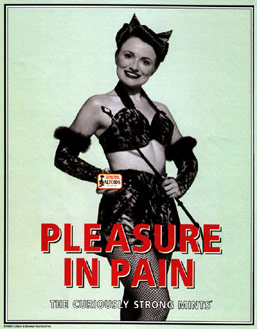
There seems to be more sex than ever before in advertising. Yet that may not be the case. One study found that in the United States, the percentage of sex in ads remained flat from the 1960s to the 1980s. What did increase during that time was the explicitness of sexual content.
Does sex sell? A successful promotional campaign depends on its overall quality, and the use of sex is no guarantee of quality. In fact, a campaign that uses sex can backfire if it is fails to accurately gauge the response of a product's target consumers. An insulted or outraged public may boycott the product!

The impression of more sex in media in the late nineties and early twenty-first century may be because there are simply more ads today overall. Media critics Sut Jhally and Jean Kilbourne cite studies that suggest that we see or hear over 3000 ads a day: billboard, radio, TV, newspaper, magazine, and Internet ads, promotions on the products we use, and even on the clothes we wear (especially T-shirts). We may soon be seeing ads on mylar screens that orbit the earth from the upper atmosphere! (Will they allow sex on space ads?)
There is every sign that as our exposure to ads increases, our exposure to ad sex will, too. The way ads represent sex affects how people think about sex, view their bodies, the bodies of others, and even how people experience sex. Advertisers and designers have a responsibility to use sexual themes with care.
This intensification of ad sex is in part because advertisers face heightened competition, especially for products such as jeans, alcohol, and perfume. But the change also reflects social changes. Overall, there is more information and more straightforward media exposure of sex than ever before, and advertising often stands at the frontiers testing new cultural limits.
Most ad sex can be found in magazines, especially fashion magazines. Sexual ads are less common on television. Ads are more likely to spark controversy if they appear on the public, communal spaces of TV or on billboards. Magazines and the Internet offer a more private exchange between the medium and the individual consumer.
Sex gets you noticed, and that's why there's more of it in ads overall, and why ads with sex are more explicit than ever. In a sea of advertising, it is no wonder that sexual themes stand out. They are the ones we notice and remember.
A more fundamental reason that sex is so ubiquitous is simply that it is central to our lives:
Advertising draws upon and works with social values, either to affirm or reinforce them or to play with and challenge them. When a sexy ad excites the consumer, he or she links that feeling with the product. The opposite is also true: an ad that turns a consumer off can turn him or her against the product.
An ad works when it incites positive emotions, whether by invoking beauty, sensuality, arousal, romance, or humor. It can also succeed when it is provocative and memorable, even worthy of discussing with friends. Which type an advertiser chooses depends on the cultural context in which the ad is created and displayed.
Ads with sex appeal draw you in by linking a product with a certain lifestyle. Buy this product, they say, and you will be like these beautiful people. Buy this product and these people will want you socially and even sexually. Buy this product and you yourself will attain sex appeal.
Sex has been linked most often to three products in particular: cars, alcohol, and cigarettes. These products have so frequently been tied to sexuality, that like Pavlov's dogs, we salivate in anticipation when we see them. Involuntarily, we associate them with sex.
The ads depict ways we can bring these desirable things, people, and activities into our lives. The ads offer an ideal, a fantasy, a reverie or departure from reality, yet they use signs we respond to because they have some basis in real life. The products the ads sell are attainable. When we buy them we gain not only these material goods, but the social values -- beauty, luxury, class, status, power -- that go with them.
All products have "lifestyle" appeal. By choosing them you show character and style. You set yourself apart from the crowd. Your choice of liquor says something about who you are. By smoking a certain cigarette you stand apart (and thanks to new bar laws, probably outside).
- Excerpt from Sex in Media, Lisa Douglass, Ph.D.